 "Taylor Martin" (tjmartin)
"Taylor Martin" (tjmartin)
09/12/2020 at 15:27 ē Filed to: None
 2
2
 23
23
 "Taylor Martin" (tjmartin)
"Taylor Martin" (tjmartin)
09/12/2020 at 15:27 ē Filed to: None |  2 2
|  23 23 |
Hey everybody!
As some of you know, I now have a part time gig writing about cars. Itís awesome and all, but thereís a problem: I donít get to choose what I write about. Thereís a very big algorithm that measures how likely a story is to be popular and statistically successful and blah blah blah. Meanwhile, the cars I like the most were hardly ever ďstatistically successfulĒ even as they rolled of the production line. So, here we are!
Every so often (maybe every week, though with me thatís real optimistic), Iíd like to do a writeup on odd cars that have struck my fancy in one way or the other. Interesting styling, fascinating stories, or both. I have a big list of cars that Iíve come across while scouring the interwebs, this just gives me an excuse to write about things I like, and learn more about it. They say the best way to learn something is by teaching it to others... I think...
One last disclosure: Iím magnificently stupid.
Youíve likely heard of every single car on my big, long list of odd cars (i.e. Oddomobiles... get it?), which means youíll be able to catch any mistakes I make in a write up. Please do. Criticize, point out, call me a numb nut, whatever.
So without further adieu, enjoy? Or enjoy! Whichever floats your boat.
!!! UNKNOWN CONTENT TYPE !!!
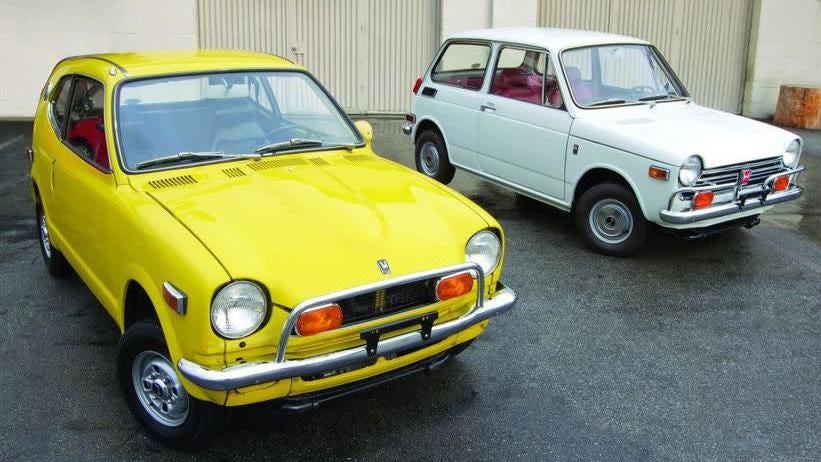
A Honda Z600 (Left) and N600 (Right)
The Japanese and American domestic markets are vastly different, and to say theyíre two ends of a spectrum may be an understatement. On one side, there are incredibly particular regulations to make smaller cars, ones that save gas and take up less space on the road, more enticing to buyers. On the other, gas prices arenít a huge issue, and to the average buyer, bigger is better. Iím sure you can guess which is which, but that doesnít make it any less fascinating when these two markets meet halfway.
But before we witness the crossover, we need a quick history lesson:
In 1949, the Japanese government wanted to support their growing car industry, but being in the post-war era made that tricky. While America was living large and enjoying the spoils of war, Japan was still recovering from their devastating loss. At the time, some families could scrape tog ether enough money for a motorbike, but not a motorcar.
So, the Kei car (or ďlightĒ car) regulations were put into place, which limited the maximum size (9.8ft long and 4.3ft wide) and engine capacity (360cc), which helped with lowering emissions and making city parking easier (with the sprawling population of Japan packed into incredibly dense cities, easier parking was a big plus). And, on top of those added benefits, buyers would be rewarded with tax and insurance breaks.
Fast forward to 1969. Honda is now a major player in Japanís domestic automotive industry. What started as a motorcycle company, now was a leader in Kei car sales (though by then, the Kei car appeal had significantly died down in favor of small passenger cars like the Toyota Corona and Nissan Bluebird). But now, after having exported their motorbikes for years, Honda automotive was ready to make their move onto the world stage.
Thus, the Honda N600 got shipped overseas to Hawaii in 1969, with plans to export there exclusively, but ended up exporting to the West Coast in 1970.
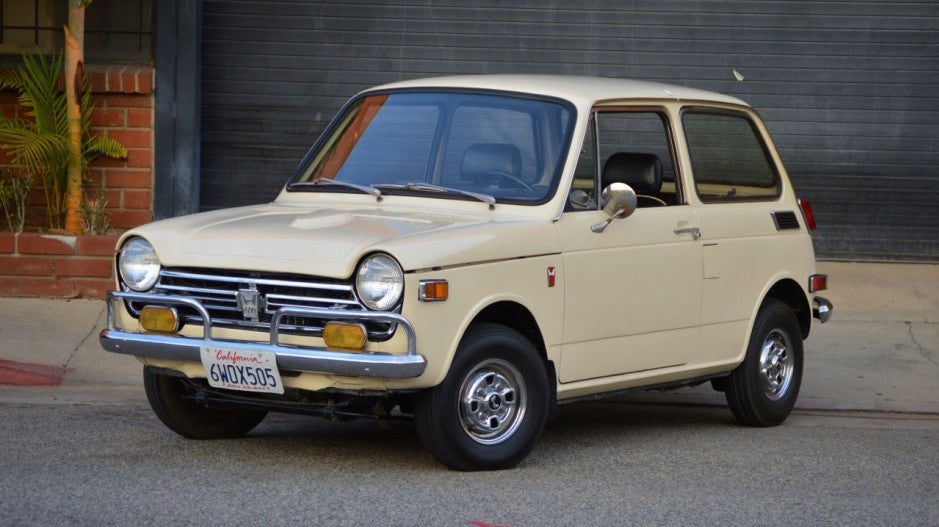
Honda N600
The N600 (which shared some styling similarities with the original Mini) was a beefier version of the N360 Kei car, though not by much. Rather than having a government regulated 360cc engine, the N600 had a... well... 600cc engine. Cars exported from Japan to America didnít have to follow the same rules, and could get away with the extra displacement.
The N600 wasnít a massive success, even in Japan, despite being marketed as a better version of the Beetle (which was true in many ways). In Japan, the N600 didnít meet Kei car regulations, which meant buyers would have no real incentive to purchase it over the N360. And in 70s America, being a small car with low fuel consumption wasnít exactly a good selling point. It was incredibly cheap, and tried to cash in on the small car craze, but it never did.
Yet another Honda came to America, on the same boat as the N600, in 1970:
The Honda Z600
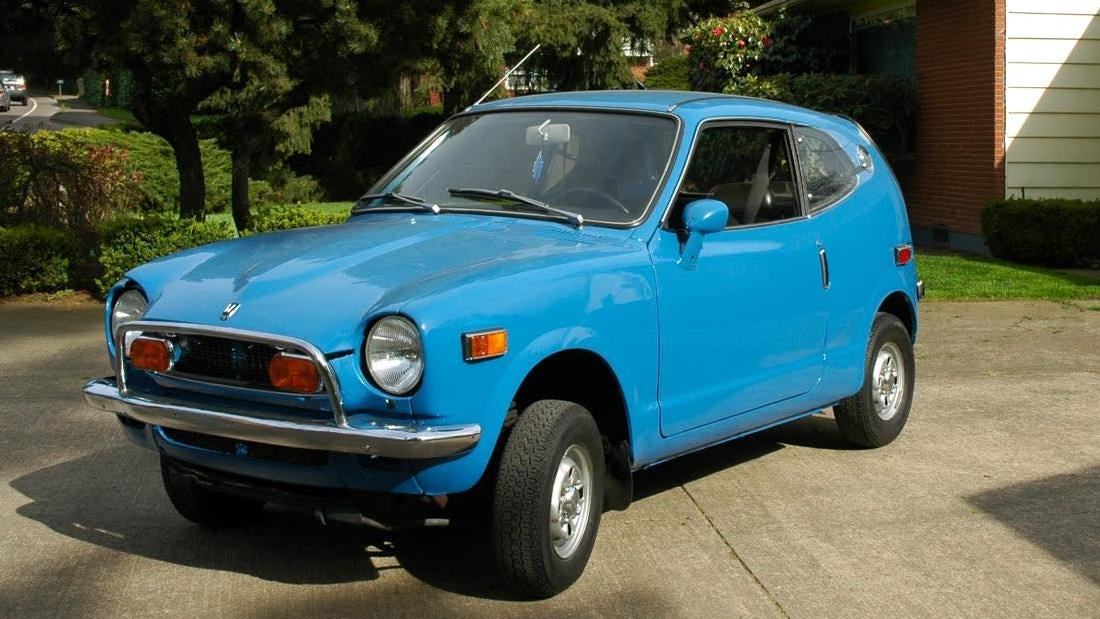
Honda Z600
Marketed as the ďsports coupeĒ version of the N600, the Z600 churned out 36 horsepower (7 more than the N600) and achieved a top speed of 75mph (3mph faster than the N600). The differences between the two are quite small, though the difference in price was substantial. The N600 was sold for around $1,300 while the Z600 was sold at about 1,600. By todayís standards, thatís a $2000 difference, for some changes to the bodywork that made the car a little bigger (and look like an inflated AMC Gremlin... if you squint).
Unsurprisingly, the Z was considered underpowered, especially while American and European automakers were introducing the Vauxhall Firenza (3x as powerful) and the Chevy Monte Carlo (7x as powerful).
Another cause for alarm was the engine itself, which was incredibly noisy and managed to shake the car despite its size. Flogging the car could be fun, in the same way driving a go kart is fun today, but the two cylinders would be screaming and kicking the entire time. The two pistons were mounted in parallel to each other, pumping up and down and up and down in perfect unison, which was the key contributor to the car shaking at idling speed.
So, without the pedigree of being Hondaís first car exported to the US, and with only just enough power to handle the American highway system, and with a heftier price tag, more Americans leaned towards purchasing the N over the Z. But I wouldnít call either of them a commercial success.
Both cars never made it past 1972. But in 1973, a much more important car was released and ready to take the world by storm: The Honda Civic
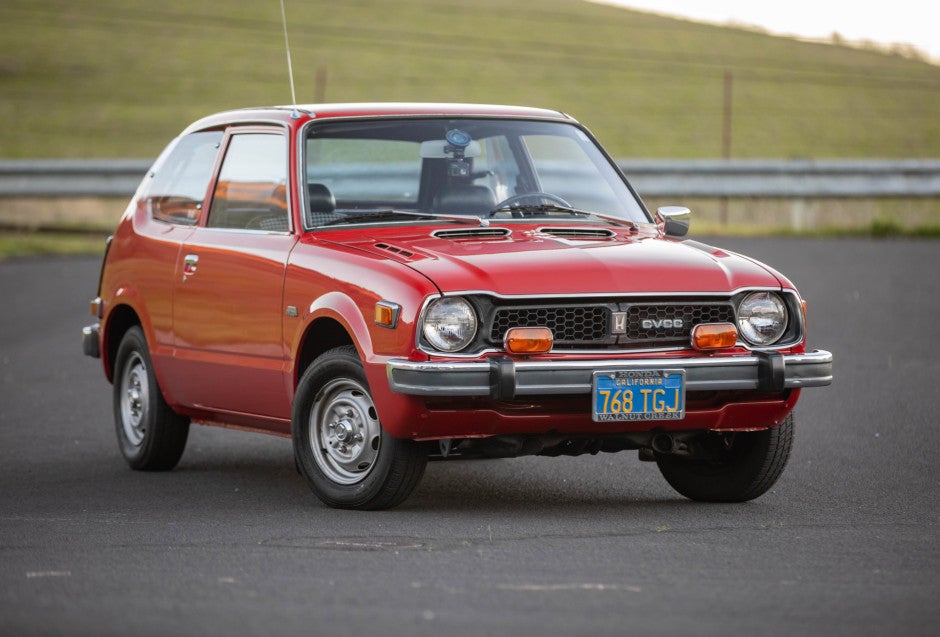
The First Generation Honda Civic, Which Debuted In 1973.
What the N600 and Z600 lacked in commercial success (and rear legroom), they made up for in paving the way for one of the most innovative cars of the time. The Civic managed to be the first car to meet Americaís new, and quite vigorous Clean Air Act with its CVCC engine.
It was a marvel of itís time, and if Honda had decided to stick with exporting motorcycles and keep the cars to themselves, it mayíve never happened.
 4kc
> Taylor Martin
4kc
> Taylor Martin
09/12/2020 at 15:57 |
|
ďMost people had enough money for a motorbike, not a motor vehicle.Ē
This isnít a factual statement, even if it is the opinion presented in the Wikipedia article about Kei cars... Some families could afford to share a car or a motorcycle, but would be a few years before the average Japanese could even afford a motorcycle.
In the late 40's and early 50's Japan created different tax brackets for vehicles to encourage economic growth that were extremely successful along with many other regulations. By the 60's Japan had one of the biggest economies in the world.
 onlytwowheels
> Taylor Martin
onlytwowheels
> Taylor Martin
09/12/2020 at 16:15 |
|
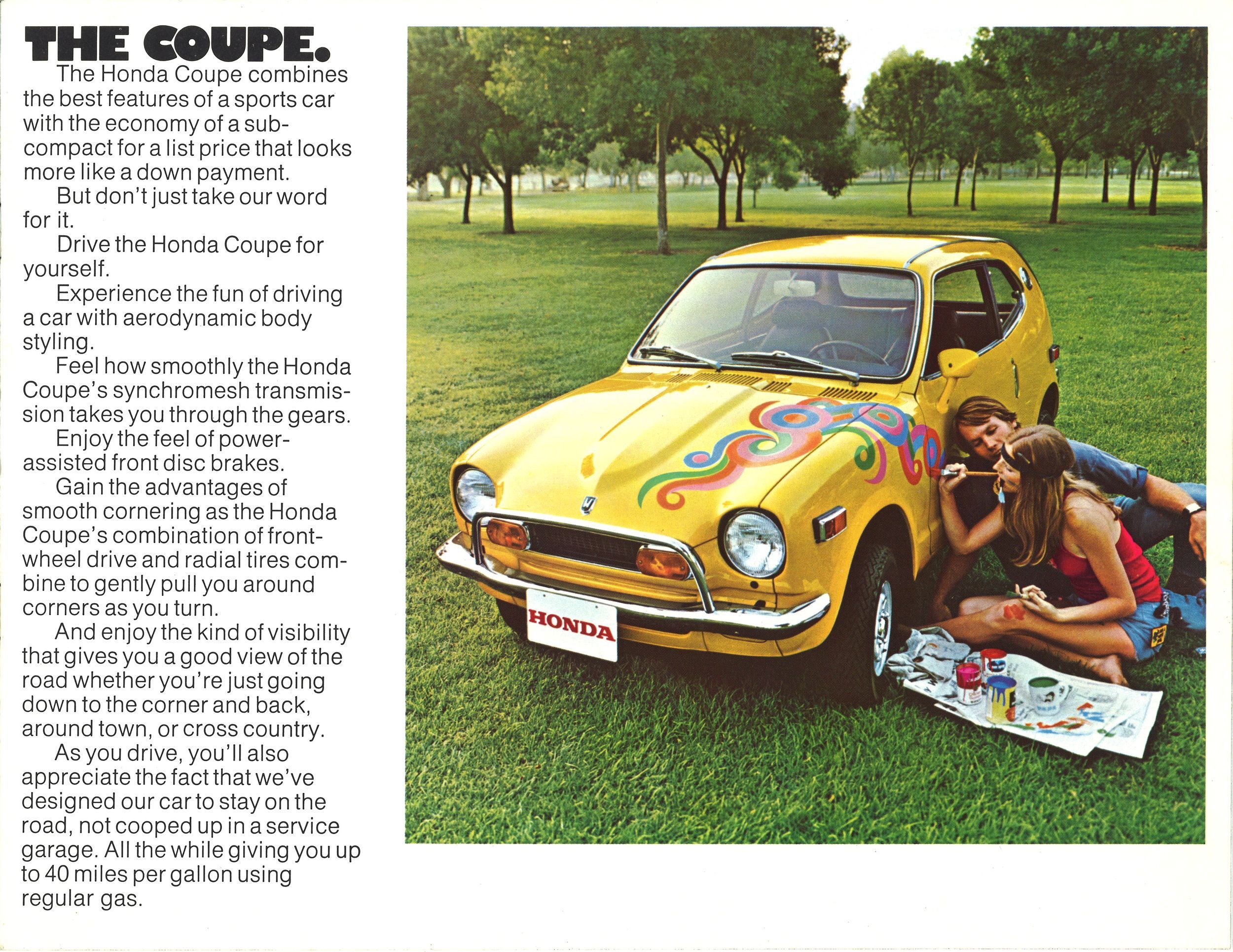
My aunt BJ bought one new when they first came out. Sh e left it behind † when she took off for Alaska, a few years later, with her boyfriend who had taken a job working on the Trans-Alaska Pipeline. No one in the family wanted the Z 600 , so my grandparents sold it .
 The Crazy Kanuck; RIP Oppositelock
> Taylor Martin
The Crazy Kanuck; RIP Oppositelock
> Taylor Martin
09/12/2020 at 16:41 |
|
The Z600 can do 150mph in Gran Turismo †4 with large shot of nitrous.†
 Taylor Martin
> 4kc
Taylor Martin
> 4kc
09/12/2020 at 16:42 |
|
Ah, I guess my frame of reference in saying that was a bit off. So did the Kei car become truly affordable around the 60's, after all the taxes and regulations had been settled and Japanís economy boomed?
I went ahead and changed people to families, since it does make more sense that not everyone could afford even that, especially 5 years after the war ended. Thanks for catching that.
 Taylor Martin
> onlytwowheels
Taylor Martin
> onlytwowheels
09/12/2020 at 16:44 |
|
Thatís a bummer, wouldíve been a neat little keepsake. T hough your aunt sounds like a well traveled person regardless .
 Taylor Martin
> The Crazy Kanuck; RIP Oppositelock
Taylor Martin
> The Crazy Kanuck; RIP Oppositelock
09/12/2020 at 16:47 |
|
Anything can do 150 with enough nitrous... though some would consider it unwise...
 Berang
> Taylor Martin
Berang
> Taylor Martin
09/12/2020 at 16:56 |
|
Iíd say the N/Z600 was a resounding sales success in the U.S. In 1971 Honda sold just short of 10,000 cars, in 1972 they sold just over 20,000 cars. For an import in that era, thatís actually pretty big numbers. Renault, for example was doing about the same numbers at the time, despite having been established in the U.S. market for decades.
Subaru of America tried with the 360, and doubtlessly this inspired Honda to take a slightly better aimed shot. But the 360 was an older design, and Subaru were not interested in producing a larger engine for export, for a car nearing the end of its production life. Once the initial novelty buyers had their cars, Subaru sales tanked, whereas Hondaís increased.
 Berang
> Taylor Martin
Berang
> Taylor Martin
09/12/2020 at 17:06 |
|
Also a motorbike is a motor vehicle, so that sentence doesnít quite make sense.
Kei cars didnít really become in reach of most Japanese families until th e mid 60s. Subaruís 360 was the first real success in the market, but despite being available since 1958, it wasnít until about Ď63-í64 that sales really took off (pre Ď63 Subarus are a rarity in Japan today) . By 1968 cars sales were going well enough that Fuji Heavy Industries no longer saw a future in producing their line of motor scooters.
 4kc
> Taylor Martin
4kc
> Taylor Martin
09/12/2020 at 17:22 |
|
Iíd agree with that. The average wage in Japan more †than effectively doubled from 1950-1960. The early 50's was al so the first time women in modern Japan could have regular jobs, so household income potentially more than quadrupled in just a decade; not even counting the many more options for jobs available than even pre-war. By the 60's a Kei was definitely in the affordable range for the average family, but in the early 50's even a Kei was still aspirational.
 Taylor Martin
> Berang
Taylor Martin
> Berang
09/12/2020 at 17:42 |
|
I had no clue Renault even exported to the states, which just goes to show what I know about things. Though Iíve learned something, which is the whole point, so thank you kindly.
The 360 is another one of the cars on my big long list of cars I like that nobody else has ever heard of. It makes sense that Subaru went in head-long while Honda took a tactical approach.
I would argue that a cars success could be measured in how long it ran for. The N600 wanted to be a rival to the Beetle, but it only lasted three years give or take in the states. Had the Civic not come around in 73, I donít think The N/Z600 wouldíve lasted too much longer. They were somewhat dying out in Japan already, even as a Kei car (until the regulations changed a bit).
 Taylor Martin
> 4kc
Taylor Martin
> 4kc
09/12/2020 at 17:49 |
|
Thatís really interesting. I mean, Iím on the outside looking in, but Kei cars do seem a little goofy. Incredibly logical, practical solutions to a very real problem, but also a but odd, which makes the idea of them being something to aspire to a little funny.
The pay rate changes make sense too, I kind of forgot that the 50s were a totally different time, and that women were still earning the right to do basic things anyone can do today, whether itís here or abroad.
 onlytwowheels
> Taylor Martin
onlytwowheels
> Taylor Martin
09/12/2020 at 17:54 |
|
They went up to Alaska in her boyfriend Martyís VW Transporter, white over blue with a few flower decals. I believe they were both hippies at that time . †
 Taylor Martin
> onlytwowheels
Taylor Martin
> onlytwowheels
09/12/2020 at 17:57 |
|
Flower Van? Hippeis? Owning a small car? Yeah, that all checks out... except for the Tr ans-Alaska Pipeline job. Iím not hippie, but a big tube that cuts through forests and pumps up oil sounds pretty anti-hippie.
 onlytwowheels
> Taylor Martin
onlytwowheels
> Taylor Martin
09/12/2020 at 18:03 |
|
It does seem quite contradictory, doesnít it?† My guess is that even hippies can be bought.† I know the pipeline jobs were paying well above what was being offered in the lower 48.
 Berang
> Taylor Martin
Berang
> Taylor Martin
09/12/2020 at 19:01 |
|
I guess there are a few things to consider, Subaru had no stake in Subaru of America, other than selling them cars. So if they wanted something changed - Subaru wasnít likely going to put much into it. They did make some concessions to American tastes, the US spec cars all had the optional 4 speed transmission (vs. the stock 3 speed) and the optional 25hp engine (vs. the stock 20hp). And that was about it, other than moving the controls over to the left hand side of the car (and on early cars, the front and rear hood releases remained on the right side of the car!).
The thing about the beetle is interesting, because though the N600 only lasted till Ď73, †by that time Beetle sales were also in decline in the U.S. (and had been falling in Germany since 1967? IIRC). The N600 occupied a distinctly different market segment I think, and it was perhaps fortuitous that the British Mini had left the US market in 1968, opening up space for the Honda to scoot in. I think that it was front wheel drive helped too, as after the miniís departure, there really werenít any cheap front wheel drive cars left in the U.S. The Fiat 128 was right around the corner, but there was still an unmet demand for a moment there.
 Taylor Martin
> Berang
Taylor Martin
> Berang
09/12/2020 at 19:27 |
|
Ah, you know, the FWD is true. The N600 was in a class of its own in that regard, at least for a flickering moment. I guess itíd be better to sell 20,000 cars in 3 years than it would be 2,000 cars in 6 (just throwing hypothetical numbers out), but you canít argue that the Beetle kept a cult following through the years, whereas I hadnít heard much about the N600/Z600 until very recently. Thatís kind of the main reason I like the N/Z600 more, because it hasnít been crammed down my throat so much.
I just watched a short video on Subaru of America, and youíre right, they didnít do all that much to change the car. The things they did do were minor at best, miniscule in reality, but the car made way for the FF1 and then later the much longer running Leone to be sold in the states, which snowballed into the Subaru we know today. Itís the long running cars that make a name for a company, like. the Beetle or the Mini, while these one off cars, like the 360 or N/Z 600, get lost to time.
 Berang
> Taylor Martin
Berang
> Taylor Martin
09/12/2020 at 20:30 |
|
The aircooled Hondas have a pretty big following on the west coast. I took this photo at a car show a little over a decade ago.
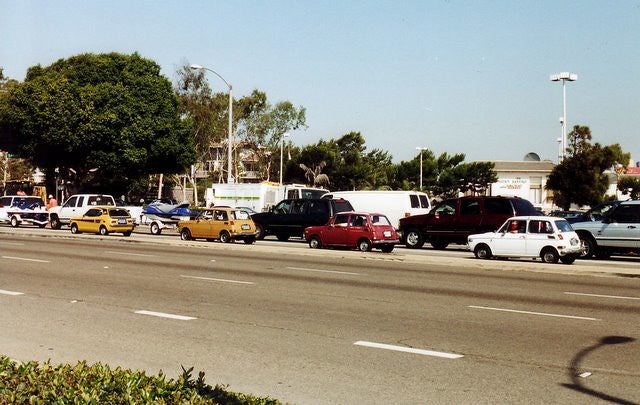
That was only part of the group that showed up (I think 12 showed up in total?) . The VW though was a national phenomenon, and honestly there arenít really any other cars out there that have a comparable following.
The situation with front wheel drive cars at the end of the 1960s is pretty interesting. As most of the pioneers had disappeared by then, and the cars that were on the market interestingly enough were not economy cars. We got the Citroen DS (the 2cv of course didnít continue into 1968 for safety reasons, and hadnít been available except by special order in the U.S. for several years prior anyway), the Renault 16, and the Saab 95/96 (which I guess could technically be considered an economy car, but it wasnít exactly cheap to buy). The Austin America had just appeared for 1969, but the less said about that the better. The Subaru Star was nominally available since 1969, but practically impossible to get a hold of until about 1971 due to Subaru of America bungling their distribution.
So Honda appeared at just the right time to get their foot in the door with the N600, to secure a successful launch of the Civic just in time for the flood of new front wheel drive econoboxes that were going to show up in the early 1970s. The reviews of the first C ivic paint the N/Z600 as basically placeholders until the Civic arrived. Itís an interesting thought, but they obviously had their own niche market as well. And obviously with tougher safety regs. coming in 1973, Honda didnít really have much choice but to dump the smaller cars.
 Taylor Martin
> Berang
Taylor Martin
> Berang
09/12/2020 at 22:00 |
|
Yeah, the N/Z600 wouldíve had a hard time getting past those safety regulations, since your kneecaps were the crumplezone. Iíve been reading up about the Civic and both the N/Z600 really were kind of the build up to the climactic fanfare that was the Civic. Itís nowhere near as exciting now, but at the time it solved a ton of brand new problems at once, from economy to emissions. Really awesome to know that the Civic was once a revolutionary, maybe even exciting piece of machinery.
I get why front wheeled cars are popular now, since t heyíre the easiest layout to make and maintain, but I donít know why people would want a FWD car in the 60s or 70s. They seemed much more scarce, and like you said, a lot of the FWD cars of the era werenít economy, so what gives?
 Who is the Leader - 404 / Blog No Longer Available
> Taylor Martin
Who is the Leader - 404 / Blog No Longer Available
> Taylor Martin
09/13/2020 at 01:47 |
|
Renault did. Iíve seen US market versions of the 10 and Caravelle (the ultra rare hardtop too!) At Old Car City USA.
Also, some British made and designed Fords made it to the US. I saw a US market Ford Anglia there too.†
 Berang
> Taylor Martin
Berang
> Taylor Martin
09/13/2020 at 02:13 |
|
Itís kind of an odd thing, but I think the Citroen DS and the Olds Toronado lent front wheel drive a sophisticated, up market image. But there was a logical reason behind this too, putting all the machinery up front meant more leg room and more trunk space, which were important in marketing a luxury car in that era.
Bad weather performance was the other big marketing shtick for FWD. Austin, DKW, and Saab had the rally wins to back this up - but when DKW disappeared in 1966 (to return in 1970 as Audi) and the Mini was pulled from the U.S. market, that pretty much left Saab as the only small front wheel drive car available in the U.S. (albeit a relatively pricey one).
So there was a nice vacancy right at the bottom of the market for people who were sold on front wheel drive, but missed the Mini.
Itís still a very odd span of time for small cars in the U.S. market. The N600 does seem distinctly old-fashioned, it belongs more among those older cars, than it does among the Civics, Rabbits, Le Cars, etc. of the 70s. Thereís this great extinction of old models in 1968, when foreign companies didnít want to invest in bringing older models up to U.S. code - and then sort of this lag time, where new models werenít available yet, and this dead period drags into the start of the 70s. And then one after another, Fiat 128, Honda Civic, Datsun F-10, VW Rabbit, Ford Fiesta, Le Car - suddenly everythingís a front wheel drive hatch back lol
 oldmxer
> Taylor Martin
oldmxer
> Taylor Martin
09/13/2020 at 05:10 |
|
my best friend had a yellow z600 when they were new, we were big Honda bike nerds so he wanted one bad. it was a blast to drive and it was solid as a rock. we drove half way across Texas in it on the interstate with 4 people inside. we got it up to 80 going downhill and realized if we got out of shape at that speed we would be goners so we trimmed it back some the rest of the way. he eventually ran it into a bridge pole after falling asleep one night. the shifter on those came out from under the dash and it impaled him and he almost bit his tongue in half. another driver saw him and called an ambulance. when they rolled him into the operating room he had so much blood in his lungs from the tongue he has no pulse. he pulled through though and fully recovered. that car had hit the pole dead on and left a perfect radius dead center. it was built well thank goodness, like a tiny tank
 Taylor Martin
> Berang
Taylor Martin
> Berang
09/13/2020 at 14:01 |
|
Automakers had no choice but to flip the switch if they wanted to claim a spot in the export market of cars. Originally, small car automakers were following the succ ess (or at least the popularity) of the Beetle with small, air cooled engines. Then bang, in an instant, the market shifted and cars had to meet new standards. It is a funky era of the small automobile, or any automobile for that matter. The small car automakers (Honda, Fiat, and so forth) just had to make their cars clean, whereas big car automakers (mostly American) had to drastically shrink their engines to meet with the new Clean Air Act and the oncoming oil crisis that made owning a gas guzzling land yacht near †impossible.
 Taylor Martin
> oldmxer
Taylor Martin
> oldmxer
09/13/2020 at 14:07 |
|
My goodness thatís gruesome man, but Iím glad your pal is okay. Iím pleasantly surprised to hear the car is a tank , thereís so much empty space in the engine bay Iím shocked the thing didnít just collapse. In the Smart car, everything is so densely packed together that itís like crashing a brick, but in this all those hollow points shouldíve just collapsed. Thereís certainly something to be said about these old, tiny cars that can take a hit.
The shifter on it is funky. I was watching a video and it looks like you have to lift up into third rather than push. Itís a funky position, but I guess there wasnít all that much usable cabin space to have the 4 speed on the floor.